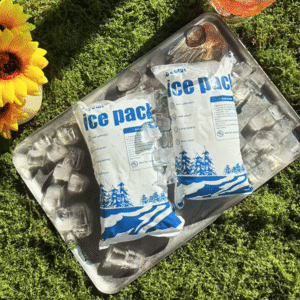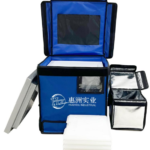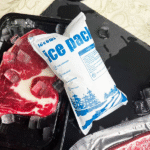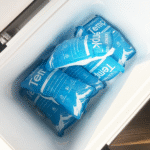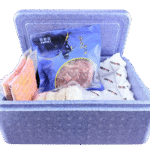Pack de glace carbonique écologique: Ce qui fonctionne 2025?
Si vous améliorez les emballages de la chaîne du froid, un eco friendly dry ice pack can cut product loss while meeting 2025 règles. Vous verrez un routage plus clair, moins de surprises en matière de conformité, et des retours plus simples. Le PPWR de l’UE est entré en vigueur le 11 Février 2025, et l'IATA a ajouté des notes de durabilité à ses réglementations sur les marchandises périssables – toutes deux font évoluer les emballages vers une réduction des déchets et un meilleur étiquetage.. Vous avez besoin d'un chemin pratique, pas des mots à la mode. Ce guide vous donne ce chemin.
-
Lequel eco friendly dry ice pack designs truly reduce total footprint across regions (UE/États-Unis) et secteurs?
-
How to size an eco friendly dry ice pack for 24–120 hours without overspending on foam or coolant load.
-
What counts as a compliant eco friendly dry ice pack under IATA PI954 and carrier-specific rules.
-
When to prefer PCMs or gel packs over an eco friendly dry ice pack for fridge-range shipments.
-
How to build a return-and-reuse loop around your eco friendly dry ice pack.
What makes an eco friendly dry ice pack sustainable in cold chain?
Réponse courte: Un eco friendly dry ice pack uses minimal materials, évacue le CO₂ en toute sécurité, avoids PFAS, convient 2025 EPR/PPWR rules, and achieves the target duration with less mass. It must prove recyclability or reusability and be easy to disassemble. It must also be labeled “UN1845” with net weight when used in air shipments and permit gas release, per IATA.
Pourquoi cela compte: Dry ice performs at −78.5 °C and is ideal for sub-zero lanes, but sustainability lives in the full system: sourcing of CO₂, masse de paquet, return rates, and product-loss prevention. EU PPWR now sets a clear direction on recyclability and waste reduction; US states are expanding EPR and PFAS restrictions. Un eco friendly dry ice pack that fits these rules—and ships safely—keeps your audits clean and your service consistent.
How do eco friendly dry ice pack materials compare to gel and PCM?
Détails: Un eco friendly dry ice pack drives deep-freeze protection; gel packs cover +2 °C à +8 °C, while PCMs target precise setpoints. Pour la durabilité, choose curbside-ready fiber shells, recycled plastics validated for food contact, and PFAS-free films. Pour +2 à +8 °C lanes, PCM bricks often outperform dry ice on cost and compliance. For −20 °C or below, a right-sized eco friendly dry ice pack remains the simplest option.
| Option vs Need | Cible température | Durée typique | Ce que cela signifie pour vous |
|---|---|---|---|
| Eco friendly dry ice pack | ≤ −20 °C | 24–120h | Strongest pull-down; ensure venting and UN1845 label; reuse outer shell. |
| Bio-based PCM bricks | +2 °C à +8 °C | 24–96 h | Réutilisable, précis; reduce overcooling risk for vaccines. |
| Packs de gel d'eau | 0 °C à +5 °C | 12–48 h | Cheap but hard to recycle; consider reuse programs. |
Conseils pratiques et gains rapides
-
International air: Declare net weight and mark UN1845; ton eco friendly dry ice pack doit éviter co₂.
-
EU lanes: Pick mono-material films and recycled content to align with PPWR 2025–2026 milestones.
-
Voies pharmaceutiques: Pour +2 °C à +8 °C, select PCM over an eco friendly dry ice pack to avoid accidental freezing.
-
Retours: Add a prepaid label and collapsible liner so customers can reuse the eco friendly dry ice pack shell.
-
Sourcing: Consider biogenic CO₂ routes where available; document energy used for pelletizing and compression.
Composite case example: A biotech replaced gel with an eco friendly dry ice pack for −20 °C international shipments. With vented fiber shippers and right-sized dry ice loads, excursions dropped and pack weight fell notably during peak season. The team met airline paperwork checks consistently and cut re-shipments in peak season.
How do you size an eco friendly dry ice pack for your lane?
Réponse courte: Model heat gain first, then match dry-ice mass to ambient profile and duration. An eco friendly dry ice pack performs best when the outer shipper, doublure, and coolant are balanced—not when you simply “add more ice.” Document the pack-out steps and verify with a 48–72 h lane test.
Plongée plus profonde: Estimate total heat load (Q) from insulation R-value and surface area, then ensure the sublimation energy of your eco friendly dry ice pack (≈571 kJ/kg) exceeds Q by a safety factor (Par exemple, 1.25×). For long-haul flights, include tarmac dwell and customs hold time. For last-mile D2C, simulate porch dwell in summer. Validate with two seasonal tests and record net weight on the airway bill.
Quick calculator you can paste into a SOP
Pack-out checklist for an eco friendly dry ice pack
-
Inspect vent paths; never seal dry ice in an airtight liner.
-
Pre-condition shipper and payload; pre-cool liner.
-
Load pellets or slabs evenly; avoid point contact with vials.
-
Apply fiber lid; mark “UN1845” and net kg on outer label.
-
Photograph pack-out for training traceability.
When is PCM better than an eco friendly dry ice pack?
Réponse courte: If the product target is +2 °C à +8 °C and the lane is under 72 heures, choisissez PCM. An eco friendly dry ice pack risks freezing biologics; PCMs hold tight setpoints with fewer documents and fees.
Explication: Les PCM sont réutilisables et non dangereux. They reduce paperwork and operator variations. But for −20 °C or -80 °C lanes, a right-sized eco friendly dry ice pack is simpler and more available globally. Many teams pair PCM legs domestically with dry-ice legs internationally, optimizing both cost and compliance.
Your decision tree (circle your box)
-
−80 °C / −20 °C for 48–120 h? Utilisez un eco friendly dry ice pack with fiber shipper and returnable liner.
-
+2 °C à +8 °C for 24–72 h? Use bio-based PCMs; skip dry ice to avoid freeze risk.
-
Ambient 15–25 °C stability? Use insulation only; no coolant beats zero waste.
-
Unknown last-mile and weekend dwell? Combine PCM bricks with a light eco friendly dry ice pack tampon.
Conformité: what rules define a compliant eco friendly dry ice pack?
Réponse courte: Le eco friendly dry ice pack must vent CO₂ and carry UN1845 marks and net weight on the waybill for air. Carriers lean on IATA/DOT; operator variations apply. Dans l'UE, the PPWR is now in force; depuis 2026 it tightens recyclability and recycled-content expectations for most packaging.
Regulatory snapshot you can share with your QA team
| Sujet | What it says | Who says it | Pourquoi ça compte pour toi |
|---|---|---|---|
| Ventilation & UN1845 | Packages with dry ice must vent CO₂ and be marked “Carbon dioxide, solid” with net weight on documents. | VOICI DGR & PI650/PI954; carriers like FedEx/UPS | Ton eco friendly dry ice pack must be vented and labeled to fly. |
| PPWR status | Regulation entered into force Feb 11, 2025; general application 18 months later. | European Commission | Your EU-bound eco friendly dry ice pack should be recyclable and lower in mass. |
| PFAS momentum | Several US states restrict PFAS in packaging; FDA says fast-food wrappers with PFAS have been phased out. | State laws; FDA | Choose PFAS-free films for any eco friendly dry ice pack. |
| US EPR | Multiple states adopting/expanding EPR for packaging, adding fees and reporting. | Industry and state laws | Budget for fees; pick lower-mass, recyclable eco friendly dry ice pack dessins. |
Bloc de documentation (copy this into your pack-out SOP)
Can an eco friendly dry ice pack reduce total emissions?
Réponse courte: Often yes—if it prevents spoilage and right-sizes materials. The CO₂ in dry ice typically comes from captured industrial streams; whether fossil or biogenic, the net climate impact hinges on the energy used to capture, compress, and pelletize, plus your return/reuse rate. A well-designed eco friendly dry ice pack can offset emissions by slashing product loss and avoiding rush reships.
What the research shows: Industrial CO₂ is frequently captured at ammonia or ethanol plants; DOE-backed projects demonstrate large-scale capture from steam-methane reformers. Emerging supply chains are piloting biogenic CO₂ to make dry ice near biomethane sites—promising but still evolving. Your plan: measure spoilage, right-size your eco friendly dry ice pack, and report results.
Metrics that make “eco friendly” measurable
-
Excursion rate (%): Each avoided spoilage shipment reduces the footprint of re-manufacture and airfreight.
-
Liquide de refroidissement kg par livraison: The most efficient eco friendly dry ice pack meets duration with less mass.
-
Taux de retour (%): Higher return = lower per-use footprint for your outer shell/liner.
-
Mono-material %: Easier disassembly, higher recycling rates in EU curbside systems.
Building a reuse loop around your eco friendly dry ice pack
Réponse courte: Design the outer shipper and liner for 5–20 cycles, and automate return prompts. A reusable eco friendly dry ice pack system pays off once reverse-logistics costs drop under the value of avoided new materials.
How to start: Pilot returns in one region for 90 jours. Use QR codes for return labels, doublures pliables, and pickup prompts after delivery. Track cycle counts per shell. Standardize on 2–3 sizes. Include a “no-ice” return step so customers never send back residual ice.
Reuse math (back-of-the-envelope)
2025 developments and trends shaping eco friendly dry ice pack choices
Aperçu de la tendance: Dans 2025, EU PPWR is live, with application from mid-2026. IATA’s manuals add sustainability considerations and clarify dry-ice-related packing details. US states continue expanding EPR and tightening PFAS rules. Bio-based PCMs are maturing fast. Ton eco friendly dry ice pack strategy should reflect this—recyclable shells, PFAS-free films, and testing that proves duration without excess mass.
Quoi de neuf en un coup d'œil
-
Calendrier du PPWR de l’UE: Law entered into force in Feb 2025; broader application about 18 months later; recycled-content and reuse options will reshape packaging specs.
-
Carrier job-aids: Carriers emphasize UN1845 markings, net weight on waybills, and venting—non-negotiables for any eco friendly dry ice pack.
-
PFAS scrutiny: Several states restrict PFAS, and the FDA reported fast-food wrappers with PFAS phased out; pick PFAS-free barriers.
-
Bio-based PCMs: Reviews in 2025 highlight bio-derived PCMs with stable performance; they complement an eco friendly dry ice pack on fridge lanes.
Perspicacité du marché: EPR fees and recycled-content requirements will increase the cost of heavy, mixed-material shippers. Lighter outer shells, mono-material films, and return programs lower both fees and emissions. Gel packs remain inexpensive but are rarely curbside-recyclable; PCMs are reusable and precise; a right-sized eco friendly dry ice pack stays essential for deep-freeze.
FAQ
Q1: Is an eco friendly dry ice pack “carbon neutral”?
Not by default. Dry ice usually uses captured industrial CO₂; the net impact depends on energy used and whether the CO₂ is fossil or biogenic. Focus on right-sizing and reuse to cut the total footprint.
Q2: Can I ship vaccines with an eco friendly dry ice pack?
Yes for frozen vaccines; pour +2 °C à +8 °C vaccines, use PCMs to avoid freezing. Always follow WHO/CDC storage rules and IATA/airline variations.
Q3: How do I label an eco friendly dry ice pack for air?
Mark «Un1845, Dioxyde de carbone, solide,” include net dry-ice weight on the waybill, et assurer la ventilation. Operator-specific variations may apply.
Q4: Is a gel pack more eco friendly than an eco friendly dry ice pack?
For fridge ranges, reusable PCMs beat both. Many gel packs aren’t curbside-recyclable; if you reuse them, they can be fine for short lanes.
Q5: What materials should I avoid in an eco friendly dry ice pack?
Avoid PFAS-coated papers/films and hard-to-separate laminates. Choose mono-material films and recycled-content fiber shells.
Résumé et étapes suivantes
Points clés: Un eco friendly dry ice pack must be vented and labeled to fly, sized by heat-load math, and built from recyclable or reusable components. EU PPWR/EPR/PFAS trends push mono-materials, contenu recyclé, et réutiliser. Pour +2 °C à +8 °C, PCMs often beat dry ice; for deep-freeze, a right-sized eco friendly dry ice pack is still best.
Que faire maintenant: 1) Map lanes and durations. 2) Test two pack-outs and choose the lower-mass eco friendly dry ice pack that still meets duration. 3) Document UN1845 procedures and state/EU rules. 4) Pilot a return loop. 5) Train teams with the SOP blocks above.
À propos du tempk
We build and validate cold-chain packaging that balances performance and sustainability. Our team blends thermal modeling with on-lane pilots to right-size your eco friendly dry ice pack and PCM systems. Expect faster pack-outs, cleaner audits, and fewer excursions across complex lanes.
Appel à l'action: Ready to design your next eco friendly dry ice pack? Book a 30-minute assessment and we’ll estimate duration, coût, and emissions for two candidate designs.






